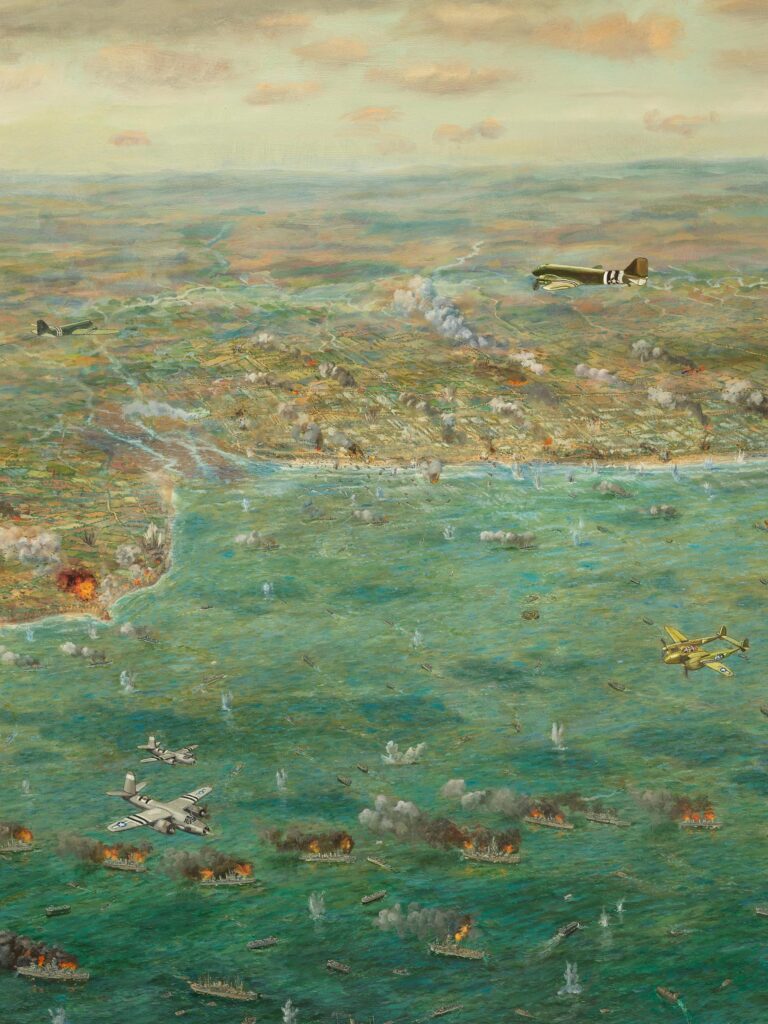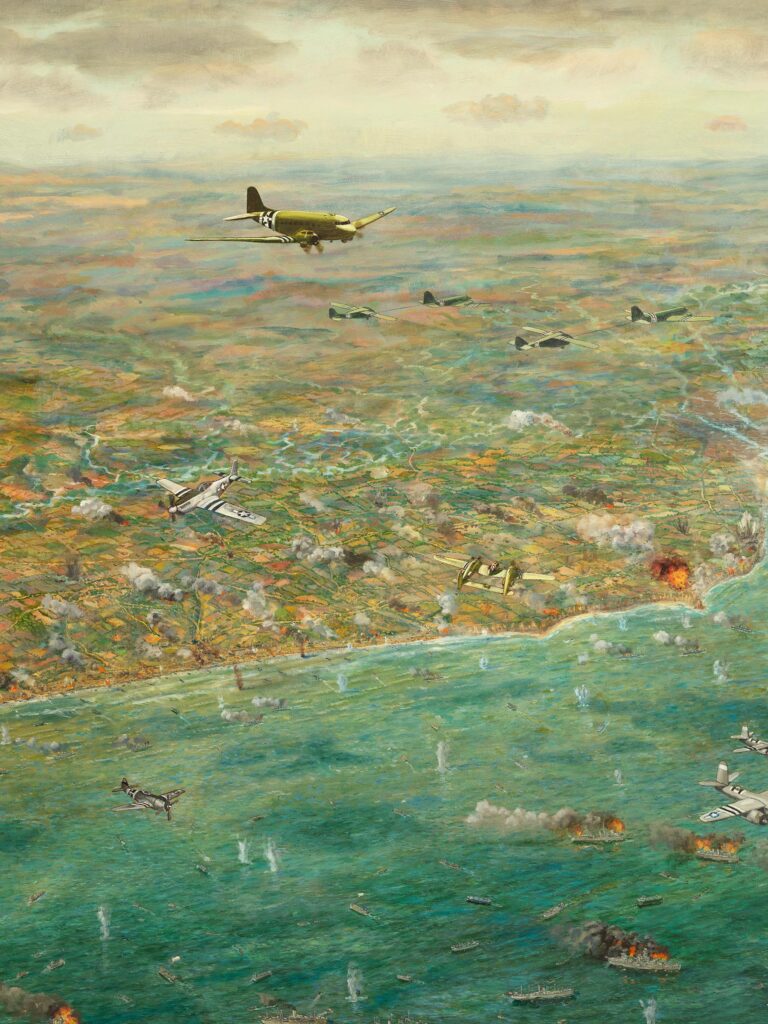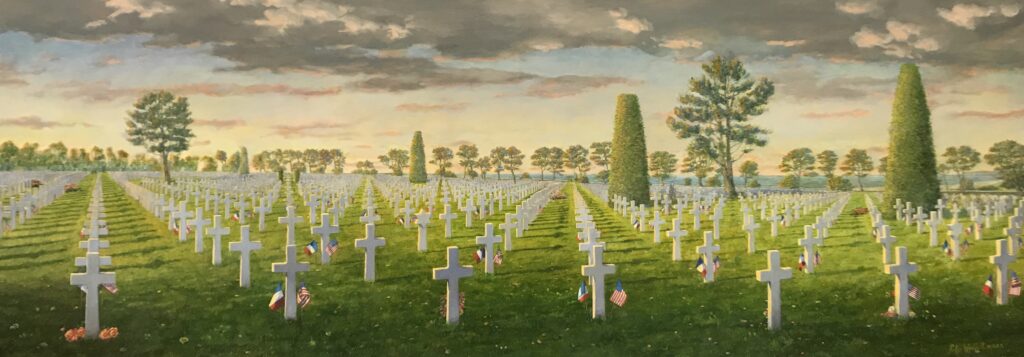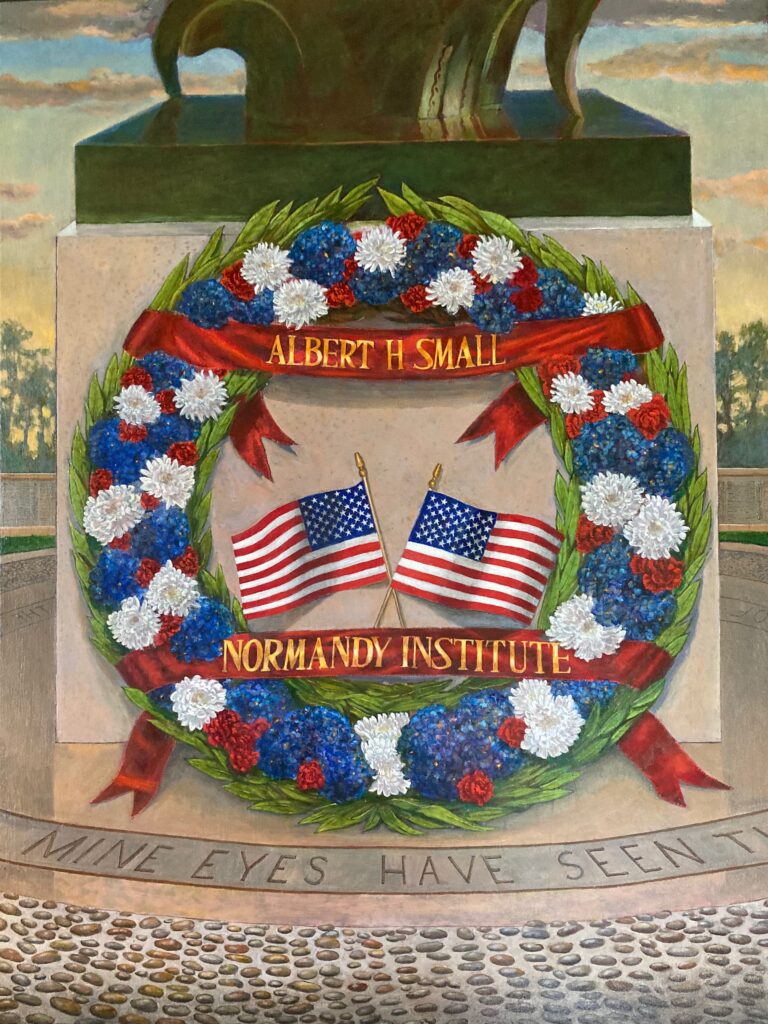Albert H. Small commissioned Peter Waddell to complete three paintings about D Day for the Normandy Institute, an organization he founded to ensure the sacrifice of D Day is not forgotten or the fact that democracy and freedom have a price.

The Defining Day
Collection of the Normandy Institute

Detail 1: The Defining Day
Collection of the Normandy Institute

Detail 2: The Defining Day
Collection of the Normandy Institute
Normandy Institute dinner remarks, July 18, 2021, Peter Waddell
Mr. Small had the vision and foresight to create the Normandy Institute to promote understanding of D Day and the cost of freedom.
As part of that mission Mr. Small commissioned from me, three paintings telling the story of the retaking of Europe by the allies, starting at Normandy on D Day, The Defining Day, and the cost of that victory, The Price of Freedom. And how the Normandy Institute is keeping the knowledge and memory of the sacrifice alive, Lest We Forget.
I hope some of you had the opportunity to see the largest of the three, The Defining Day at the Institute offices. I am going to speak briefly this evening about the process of making historically accurate works of art.
The vast mass of research necessary to create the paintings would not have been possible without Professor Long whose knowledge of D Day is prodigious, and by his many friends and contacts in the services and academia who helped answer the most arcane questions.
Mr. Small also provided researchers Ann Dobberteen, and Jackie Streker. They scoured archives and libraries for the hundreds of details I needed to make the painting accurate and true
In the painting, I have tried to bring together all that is known about the action at one moment, 9:30 a.m. on the morning of June 6, 1944. That moment was chosen with prof Long as it enabled the widest variety of stories about the day to be presented simultaneously, and it was light enough then to see them.
In the foreground, the battle ships and cruisers are pounding the German defenses. The attack support vessels are launching smaller craft carrying men and equipment to shore. All the large named vessels are accurately depicted including their exact positions. The landing craft are arriving on the beach under withering fire, but our destroyers are right close to shore providing cover.
The allies have mastery of the skies, and a variety of planes and gliders (an essential part of the story) are overhead.
I was fortunate to visit the sites depicted in the painting thanks to Mr. Small’s generosity. As well as looking at the battle sites, the Nazi defenses, and museums associated with D-Day, I was able to experience the sense of place in some very direct ways.
I read so many first-hand accounts of men approaching the beach that day (including Earnest Hemmingway’s), that I wanted to see the landscape as they saw it. Utah and Omaha Beaches, depicted in the painting, are amazingly unchanged from 1944.
I am a keen swimmer and I swam out from Utah Beach and Omaha Beach and look back to the shore and see the bluffs and dunes over which they had to fight. Swimming in the same water in which so many young men fought and died was a deeply moving experience.
I collected some sand from both beaches. I brought that sand back to my studio in Washington and mixed it with the paint I used to depict the beaches. It has become physically part of the painting.
The land above Omaha beach seen in the painting became the subject of the second painting The Price of Freedom. It is really about the cost of the glorious victory against the Nazis. It is a view of the Normandy American Cemetery looking north towards the Baie De La Seine. The Cemetery was built on a bluff overlooking Omaha Beach. It contains 9,388 United States military dead from the D Day landings and ensuing fighting. I calculate about 3,000 grave markers are shown in the painting but many of those are distant and very small. About 300 of them are close enough to see individually. Among the grave markers are several large conifers that have been trimmed into conical forms. Beyond them is a row of pine trees, and a low wall. Pines were chosen because there were similar ones in the landscape when our troops arrived.

The low wall separates the Cemetery from the steep bluff which falls away to Omaha Beach below. On the far right between the pines there is a glimpse of the beach, and beyond that, the coast leading to Gold, Juno, and Sword Beaches, where the British and Canadians fought. Caissons for Mulberry B (the temporary break water created by the Allies) are visible on the horizon.
This is a painting composed of few elements. It is a geometric arrangement of grave markers spread across perfect turf towards the horizon. Both the Crosses and Stars of David were designed by Paul Cret in 1923. Carved from vivid white Italian Luca marble they are extremely subtle in their geometry. The vertical and horizontal elements spread slightly and their intersection is curved. The effect is one of harmonious muscularity. Each marker is in some sense, a person.
The almost abstract arrangement of markers in complex perspective patterns with vanishing points in all directions is illuminated by evening sun and the light of dusk warms the scene. The ocean spreads to a distant horizon.
The third painting Lest We Forget is about how the Albert Small Normandy institute helps keep the knowledge and memory of D Day alive.

The painting shows the wreath laid by the students, composed of red white and blue flowers, (carnations, chrysanthemums, and hydrangeas), surrounded by laurel leaves. Two red silk ribbons proclaiming the Albert H Small Normandy Institute cross the wreath. Two small American flags are attached to the wreath.
The wreath is shown where it was laid at the cemetery, against the plinth of the massive bronze sculpture The Spirit of American Youth Rising from the Waves by Donald De Lue. The abstracted bronze waves of the sculpture are visible above the wreath.
The wreath was laid before each student eulogized a soldier from their home town who is buried or commemorated at the cemetery.
In front of the plinth are the words “mine eyes have seen” inlaid in metal letters, part of the phrase “mine eyes have seen the coming of the lord” which surrounds the plinth. The other surface in foreground is composed of tiny smooth pebbles collected from Omaha Beach where the men came ashore. So, the students stood on the same ground as the soldiers when they landed.
On either side of the plinth can be seen sections of the Wall of Missing Soldiers, commemorating the soldiers whose bodies were never found. Beyond the wall are the pines so characteristic of the Cemetery.
The painting celebrates the sacrifice of our men defending democracy and freedom on the beaches of Normandy, and also the work of the students and teachers attending The Normandy Institute, and the generosity of Albert H Small and the Small family helping keep the memory of D-Day alive.
As Professor Long says, “D-Day was massive, complex, and uncertain.” These paintings are to help convey the truth of that.
